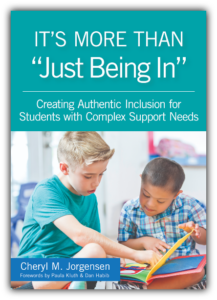What constitutes authentic membership in a classroom? As inclusion expert Cheryl Jorgensen says, it’s about much more than a student’s physical presence in the classroom:
“Membership is more than simply tolerance; it comprises all the symbols and signs of belonging that are afforded to typical students in a classroom and within the larger school environment.”
 Today’s post shares 15 indicators of true membership, excerpted and adapted from Cheryl Jorgensen’s inclusion guidebook It’s More Than “Just Being In.” Use this list as a guide to be sure that students with disabilities experience the same sense of belonging as typically developing students in your school and classroom.
Today’s post shares 15 indicators of true membership, excerpted and adapted from Cheryl Jorgensen’s inclusion guidebook It’s More Than “Just Being In.” Use this list as a guide to be sure that students with disabilities experience the same sense of belonging as typically developing students in your school and classroom.
- The student attends the school they would attend if they did not have a disability.
- The student’s class and other activities in which they are involved have a natural proportion of students with and without disabilities (i.e., the same percentage of students with and without disabilities as are present in the school population).
- The student is a valued member of an age-appropriate general education class.
- The student’s name is on all class lists, group lists put on the board, job lists, and so forth.
- The student participates in classroom and school routines, such as the Pledge of Allegiance, lunch count, jobs, errands, eating lunch in the cafeteria, and changing classes, in typical locations and at the same times as classmates without disabilities.
- The student receives accessible print and other learning materials in accessible formats at the same time those materials are provided to students without disabilities.
- The student participates in classroom instruction in similar ways as students without disabilities, including whole class discussion, writing on the board, small-group discussion, and projects. The student is called on by the teacher as frequently as other students in the class.
- The student rides the same school bus as their peers without disabilities, arriving and leaving at the same time.
- The student makes the transition between classes alongside their peers without disabilities, arriving and leaving at the same time.
- The student progresses through the grades according to the same pattern as students without disabilities.
- The student learns in outside-of-school, age-appropriate, and inclusive environments before the age of 18 only when such instruction is the norm for typical students.
- Related services and specialized instruction are provided within the typical routines of a school day in addition to, not in place of, core general academic instruction.
- Related services are delivered primarily through embedded instruction in the classroom or prior to or after the school day.
- The school is physically accessible so that the student and other individuals with mobility challenges have full access to all activities and environments within the school building.
- The school accommodates the student’s sensory and health care needs.
Membership in a general education classroom falls along a continuum of “not included at all” to “having all the signs and symbols of membership afforded to classmates without disabilities.” Where do the students in your school fall on this continuum? If you need more guidance on creating authentically inclusive learning environments, add It’s More Than “Just Being In” to your professional library—plus our bestselling how-to books from inclusion experts like Paula Kluth, Julie Causton, and Nicole Eredics

It’s More Than “Just Being In”
Creating Authentic Inclusion for Students with Complex Support Needs
By Cheryl M. Jorgensen, Ph.D.
“Open any page of this book and you will find real-life examples, strategies, and ideas to connect the IEP to learning and participation in inclusive classrooms in easy-to-use formats. Best of all, owning this book is like having a personal mentor and friend with you on your journey to create inclusive environments!”—Elizabeth Keefe, Emeritus Professor, University of New Mexico
Stay up to date on the latest posts, news, strategies, and more!
Sign up for one of our FREE newslettersTopics
More posts like this

Tips for Inclusive School Communities: Building Belonging & Equity
February 20, 2024
10 Quotes about Creating an Authentically Inclusive Classroom
January 9, 2024


Write a Comment
Your email address will not be published. Required fields are marked *
Post a Comment